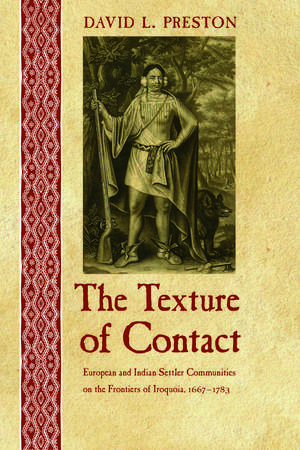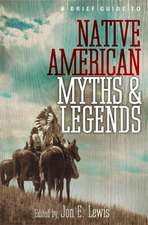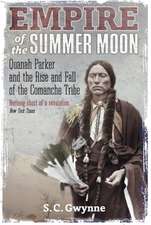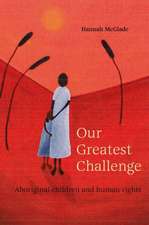The Texture of Contact: European and Indian Settler Communities on the Frontiers of Iroquoia, 1667-1783: The Iroquoians and Their World
Autor David L. Prestonen Limba Engleză Paperback – 15 oct 2012
The Texture of Contact is a landmark study of Iroquois and European communities and coexistence in eastern North America before the American Revolution. David L. Preston details the ways in which European and Iroquois settlers on the frontiers creatively adapted to each other’s presence, weaving webs of mutually beneficial social, economic, and religious relationships that sustained the peace for most of the eighteenth century.
Drawing on a wealth of previously unexamined archival research, Preston describes everyday encounters between Europeans and Indians along the frontiers of the Iroquois Confederacy in the St. Lawrence, Mohawk, Susquehanna, and Ohio valleys. Homesteads, taverns, gristmills, churches, and markets were frequent sites of intercultural exchange and negotiation. Complex diplomatic and trading relationships developed as a result of European and Iroquois settlers bartering material goods. Innovative land-sharing arrangements included the common practice of Euroamerican farmers living as tenants of the Mohawks, sometimes for decades. This study reveals that the everyday lives of Indians and Europeans were far more complex and harmonious than past histories have suggested. Preston’s nuanced comparisons between various settlements also reveal the reasons why peace endured in the Mohawk and St. Lawrence valleys while warfare erupted in the Susquehanna and Ohio valleys.
One of the most comprehensive studies of eighteenth-century Iroquois history, The Texture of Contact broadens our understanding of eastern North America’s frontiers and the key role that the Iroquois played in shaping that world.
| Toate formatele și edițiile | Preț | Express |
|---|---|---|
| Paperback (1) | 224.43 lei 6-8 săpt. | |
| Nebraska Paperback – 15 oct 2012 | 224.43 lei 6-8 săpt. | |
| Hardback (1) | 345.11 lei 3-5 săpt. | |
| Nebraska – oct 2009 | 345.11 lei 3-5 săpt. |
Din seria The Iroquoians and Their World
-
 Preț: 192.66 lei
Preț: 192.66 lei - 18%
 Preț: 970.29 lei
Preț: 970.29 lei -
 Preț: 172.48 lei
Preț: 172.48 lei -
 Preț: 134.86 lei
Preț: 134.86 lei -
 Preț: 248.10 lei
Preț: 248.10 lei -
 Preț: 429.67 lei
Preț: 429.67 lei -
 Preț: 323.53 lei
Preț: 323.53 lei -
 Preț: 178.00 lei
Preț: 178.00 lei -
 Preț: 133.00 lei
Preț: 133.00 lei
Preț: 224.43 lei
Nou
Puncte Express: 337
Preț estimativ în valută:
42.94€ • 45.08$ • 35.64£
42.94€ • 45.08$ • 35.64£
Carte tipărită la comandă
Livrare economică 10-24 aprilie
Preluare comenzi: 021 569.72.76
Specificații
ISBN-13: 9780803243521
ISBN-10: 0803243529
Pagini: 408
Ilustrații: 12 illustrations, 3 maps, 3 tables
Dimensiuni: 152 x 229 x 29 mm
Greutate: 0.59 kg
Editura: Nebraska Paperback
Colecția University of Nebraska Press
Seria The Iroquoians and Their World
Locul publicării:United States
ISBN-10: 0803243529
Pagini: 408
Ilustrații: 12 illustrations, 3 maps, 3 tables
Dimensiuni: 152 x 229 x 29 mm
Greutate: 0.59 kg
Editura: Nebraska Paperback
Colecția University of Nebraska Press
Seria The Iroquoians and Their World
Locul publicării:United States
Notă biografică
David L. Preston is an associate professor of history at the Citadel.
Cuprins
List of Illustrations
Acknowledgments
Introduction: Under the Tree of Peace
1. The Tree of Peace Planted: Iroquois and French-Canadian Communities in the St. Lawrence Valley
2. Iroquois Communities in the Eighteenth-Century Mohawk Valley: Schoharie, Tiononderoge, and Canajoharie
3. Dispossessing the Indians: Proprietors, Squatters, and Natives in the Susquehanna Valley
4. "The Storm Which Had Been So Long Gathering": Pennsylvanians and Indians at War
5. "Our Neighbourhood with the Settlers": Iroquois and German Communities in the Seven Years' War
6. Imperial Crisis in the Ohio Valley: Indian, Colonial American, and British Military Communities
Epilogue: The Tree of Peace Uprooted
List of Abbreviations
Notes
Bibliography
Index
Acknowledgments
Introduction: Under the Tree of Peace
1. The Tree of Peace Planted: Iroquois and French-Canadian Communities in the St. Lawrence Valley
2. Iroquois Communities in the Eighteenth-Century Mohawk Valley: Schoharie, Tiononderoge, and Canajoharie
3. Dispossessing the Indians: Proprietors, Squatters, and Natives in the Susquehanna Valley
4. "The Storm Which Had Been So Long Gathering": Pennsylvanians and Indians at War
5. "Our Neighbourhood with the Settlers": Iroquois and German Communities in the Seven Years' War
6. Imperial Crisis in the Ohio Valley: Indian, Colonial American, and British Military Communities
Epilogue: The Tree of Peace Uprooted
List of Abbreviations
Notes
Bibliography
Index
Recenzii
"Preston has created an original and stimulating narrative by engaging with frontier peoples on their own lands and on their own terms."—Christopher Bilodeau, Ethnohistory
"Well-written, thoroughly researched . . . . [Preston's] major contribution is the wonderful descriptions of Indian economic, cultural, and social relations with diverse whites in the Mohawk Valley."—L. M. Hauptman, Choice
"Students of Iroquois culture and backcountry history will be surprised and challenged by this book, which shows in a new way that conflict was never inevitable in the backcountry. Even on the eve of the Revolution, there was still the possibility of Indian-European amity in the Iroquoian borderlands."—Daniel Ingram, Pennsylvania Magazine of History and Biography
"Preston is an ambitious and stimulating writer, and his book is worthy of use in the graduate or advanced undergraduate classroom."—Gregory Evans Dowd, American Historical Review
"This book is a substantive and welcome addition to the scholarship on eighteenth-century Native-settler relations. . . . Preston's engaging writing style makes the book viable for assignment in upper-level undergraduate courses and graduate seminars, and all scholars in the field will need to grapple with the implications of his significant findings regarding the importance of local, "everyday," face-to-face interactions across cultural boundaries in early America."—Jon Parmenter, William and Mary Quarterly
“The Texture of Contact deserves to be recognized for what it is, a major contribution to the ever growing body of academic studies about Indian-white interactions, both peaceful and bloody, in colonial North America. Preston’s presentation represents a sophisticated analysis that moves significantly beyond currently fashionable explanations about Indian-white interactions—and the reasons why harmony finally gave way to a bloody history of violence and the dispossession of Native Americans from their homelands.”—James Kirby Martin, Pennsylvania History











